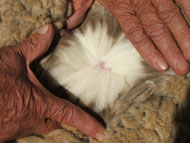
Trust your eyes when selecting sheep

Sheep selection has come the full circle. New research suggests that classing sheep on the basis of visual traits such the appearance of their wool should be incorporated into modern sheep selection strategies.
NSW Department of Primary Industries researchers have found that including visual traits with measured traits in a selection index can improve genetic gains from Merino breeding programs, through use of more efficient selection strategies.
Project leader, NSW DPI researcher Sue Mortimer said the research is expected to lead to better use of selection in identifying those animals that are superior for economically important traits.
"The findings will pave the way for greater accelerated genetic gains", she said.
Selection indexes have been used in the sheep industry since the early 1980s, when sheep genetics information became more widely available and the objectives for breeding programs were defined more rigorously.
Dr Mortimer said the project estimated the relationship between visual and measured traits and then predicted the impact of including visual traits in combination with measured traits in a range of selection indexes currently available to ram breeders.
Australian Wool Innovation funded the research, which took data sets from the Trangie QPLU$ project, the CSIRO Fine Wool Project and the South Australian Base Flock and Selection Demonstration Flocks.
"Thirty per cent or more of the effective selection differential is often directed to the visual traits independent of the measured traits," Dr Mortimer said.
Effective selection differential is an indicator of superior performance in selected animals.
In some instances, substantial improvements in fleece weight and fibre diameter can be predicted by using a mix of visual assessment and measured performance in selection indexes.
How the wool handles, wool character, colour and classer grade - when included in a range of selection indexes - contributed markedly to the overall responses predicted in genetic merit from the indexes, according to Dr Mortimer.
"Accuracy of predicted genetic merit improved between about three per cent (for classer grade and colour) and 18 per cent on average (for handle) when each of these traits was included in the selection indexes.
"This improved accuracy translates to greater predicted responses to selection."
While visually assessed traits are known to be at least moderately heritable, until now the accurate estimates of correlations required for incorporating visually assessed traits into sheep genetic evaluation programs have not been available.
Email:

